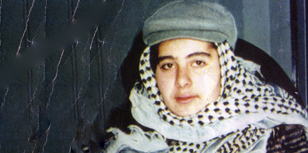Sema Yuce was born in the village of Qerqelik (Karagalik) in the Duxet (Tutak) district of Agirî in 1971. She grew up in a family of six, a household dominated by tradition.
Sema who was introduced to the Kurdish cause and struggle lived through the complications with the spirit of a rebel. Because of this, her uncle named her ‘Leyla’ after Leyla Qasim; a Kurdish female revolutionary who promoted the awareness of the oppression of Kurds; her name went down in Kurdish women’s history of rebellion and resistance. Sema carried the name with grace and lived the rebellious spirit of Leyla.
After joining the cause, Sema took on the name ‘Serhildan’. Whatever situation she may have been in, Sema was always the bearer of a rebellious spirit. Despite growing up in a society full of patriarchy and struggle, Sema always opposed sexism and inequality, even before and after the fight.
Always in the form of rebellion, she brought women one step closer to revolution. Sema completed primary school in her village, a middle school in Duxet and high school in Agirî. After high school, she earned a degree in Sociology at the Middle East Technical University; soon she met the PKK.
Sema participated in the PKK ranks in Mêrdin in 1991, after taking an active role in the struggle for Kurdish freedom, she moved to Mahsun Korkmaz Academy for further higher education. Here, she met the People’s Leader Abdullah Öcalan. “A person who can organise themselves is the best militant” – after making this statement she proceeded to move to the Serhet province with a group of comrades in the summer of 1992.
Sema’s determination for freedom and her fight against both the enemy and their collaborators expressed the current state and progression of women. Sema is a revolutionary.
When it is Newroz, it is a time for the re-birth of women and a new struggle to fight again, it adds breath to the resistance.
Sema is soon caught by the state as a result of betrayal and is sent to the Çanakkale dungeons. The torture prisoners endured here was at its highest level. Despite the torture, she never compromised with the enemy within custody and detention – she never gave up the resistance, despite suffering severe health problems.
However, Sema always lived in rebellion and is now remembered with resistance. At the time of Can Yüce, there was a great betrayal, Sema arose against this and stated, ‘we have only one leader’. This shows the precise and radical stance of women and their opposition against oppression.
After being exiled to the Çanakkale Prison, Sema became one of the officials at the prison and was at the forefront of the fight against the enemies in the same prison. Six years after entering the dungeon, on the evening of March 21, 1998, Newroz, she said she wanted to burn her brain, heart and body into a bridge that reaches from March 8 to March 21 – she was aware of the impact this action would have.
Intellectually, it reached a threshold for the Kurdish women’s movement. Sema was hospitalised for a long time and died on June 17. Her last words before she died were “I became Newroz, I became Mazlum”.
With the flag Sema took from Zekiye, by carrying it with her to the highest rank, it adds a new life to the struggle. In the face of the greatness of Sema’s revolutionary action, the enemy suffers a major defeat.
Now tens of women are fighting under the name of Sema and the glory of her resistance. Millions became Sema. Sema’s verses also have truth, love and humanity. There is love in Sema’s life; love of truth. As the young women march towards victory, they follow in the footsteps of Sema’s lines and soul.
In her poem of truth, Sema describes her love as follows:
“I was born today
Seven hundred and thirty days ago on April 1, 1999
I took my first breath in Amed,
At the Mardin Gate Signs
My midwife’s name is Zekiye Alkan
She smelled like my home town
Her burnt breast
So that my mother won’t suffer
She burned a huge fire form her body,
‘Kurdish women are rebels’”
NC / Faraşîn Sîdar




